Araden
| Araden ('Ara'den) ܐܪܥܕܢ | |
|---|---|
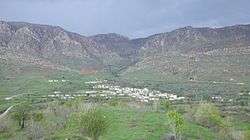 | |
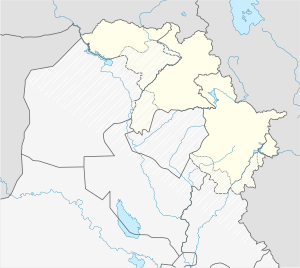 Araden ('Ara'den) Location in Iraq  Araden ('Ara'den) Araden ('Ara'den) (Iraq) | |
| Coordinates: 37°6′20.24″N 43°19′6.68″E / 37.1056222°N 43.3185222°ECoordinates: 37°6′20.24″N 43°19′6.68″E / 37.1056222°N 43.3185222°E | |
| Country |
|
| Autonomous Region |
|
| Governorate | Dohuk Governorate |
| Government | |
| • Type | Lijna, Committee |
| • Mukhtar | Toma Gidde |
| Area | |
| • Total | 18 km2 (7 sq mi) |
| Elevation | 1,723 m (5,653 ft) |
| Population | |
| • Total | 200+ (estimate) |
| Website |
www |
Araden (Syriac: ܐܪܕܢ) is an Assyrian village in the Dohuk Governorate of Iraq. It is located approximately 20-30 kilometers (12–19 miles) east of the city of Zakho The village of Inishk lies a few miles to the east, and the village of Bamerne is to the west, while Sarsing can be seen to the south. The name Araden means "Land of Eden" in Assyrian Neo-Aramaic. The village is vast, spanning over 18 kilometers and containing more than 150 homes, 3 churches and a cemetery.[2]
Two of the oldest churches in Christianity, Mart Shmoni[3] and Sultana Mahdokht,[4] (which was established in 325 AD) are located in Araden. A newer church known as Libbat Isho was established in the 1980s as well.[5]
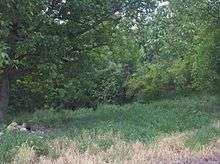
People
The inhabitants of Araden are ethnic Assyrians (Aradenites) belonging to the Chaldean Catholic Church and have continuously inhabited the land for thousands of years. The village is relatively famous among its neighboring towns and villages for having many green-eyed and red haired people. as a testament to the ancient and isolated nature of the village, The inhabitants speak Chaldean Neo-Aramaic with a unique accent closer to Old Aramaic.
There are three main families in this village: the Rayes family, the Sana family, and the Qasha family. Although the settlement in Araden is known to have existed for thousands to years prior to their arrival, as is indicated by the presence of the ancient churches in the village. The head of the village has traditionally been the first born son always named 'Youkhanna' of the Rayes family. There in Araden once lived a famous 'medicine man' named 'Shamasha Zaya' who is believed to have been second cousins with General Agha Petros.
Famed Bishop Francis Daoud, of Araden, was known for bravery and leadership during the Ottoman-directed 1915 Genocide for helping to save many Assyrians living in Northern Iraqi villages from death through bartering with the Turks & Kurds. He was confirmed a Bishop of the Chaldean Catholic Church on February 24, 1910, and served until his death on October 1, 1939, and is buried and memorialized in an ancient church in the Duhok, Iraq, region.[6][7]
During the 1959 Iraqi–Kurdish conflict the people of Araden gave land to Kurdish refugees during the Kurdish rebellions. Eventually the Kurds formed a second village in Araden called "Aradenlaya", where Kurdish families were hidden from the Iraqi military. However, the military eventually caught on to the location of the village during the First Iraqi–Kurdish War and bombed it, dispersing the Kurdish refugees to other villages. Today, those families now mainly live in the Kurdish town of Qadish, which lies about seven kilometers east of Araden.
There is a large community of 'Aradenites' in Metro Detroit, specifically (Warren, Sterling Heights, and Troy) Michigan. Every year the people of Araden gather and return to the village on January 12 when there is a celebration for Sultana Mahdokht, called Dukhrana. It is also a big event for the Iraqi Christian community of Michigan, with thousands of people attending. Also every year on 15 May, Aradnayeh get together in Shelby Township, for a large celebration at the Stony Creek Metropark, known as a "Shera".
Wildlife
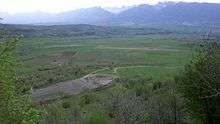
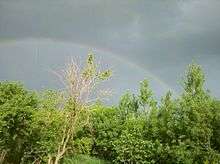
Flora
Most of the village is covered by fruit and nut bearing trees. To the north, higher up on the mountain towards a region of the land called "Gozaneh", large walnut trees grow around one of the springs that comes from the mountain. Loquat trees grow on the land below Gozaneh, along with quince, citron, orange, apple, and lemon trees. Around the residential lands, mulberry, blackberry, raspberry, and plum trees grow towards the lower edge of the village. Down in the valley towards the church Sultana Mahdokht, grows an abundance of pecan trees. However the entire region of Araden is covered in almond trees. The non fruit bearing trees include Cyprus, Cedar, Pine, Oak and spruce. In recent years, the Kurdistan Regional Government has banned the cutting of trees without a license, so these trees are beginning to grow in abundance all over the region.[8]
Fauna
After the Iraqi Kurdish government rose, many environmental protection laws were passed in the region to help restore the wildlife to the way it was before the wars that took place. Since then, the wildlife population has risen greatly due to better habitat conditions . Hedgehogs, frogs, boars, foxes, bats, bears, and wolves are just some of the kinds of animals that inhabit the stretch of land.
See Also
References
- ↑ KRG Cabinet. "The Kurdistan Region in brief". cabinet.gov.krd.
- ↑ Aradin village. "Aradin". www.ishtartv.com.
- ↑ Mart Shmune church. "Aradn Village". www.ishtartv.com.
- ↑ Sultana Mahdokht. "church in Aradn". www.ishtartv.com.
- ↑ Churches in Araden. "Galb Al Aqdas church – Aradn". www.ishtartv.com.
- ↑ Cheney, David M. "Amadiyah and Zaku (Diocese) [Catholic-Hierarchy]". www.catholic-hierarchy.org.
- ↑ Cheney, David M. "Bishop François Daoud (David) [Catholic-Hierarchy]". www.catholic-hierarchy.org.
- ↑ FLORA FAUNA. "The Kurdistan Region's flora and fauna". cabinet.gov.krd.